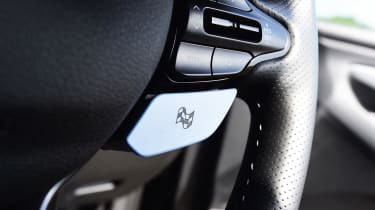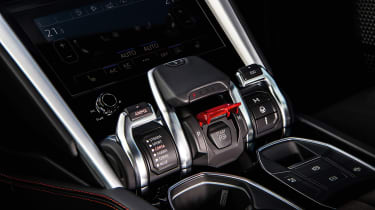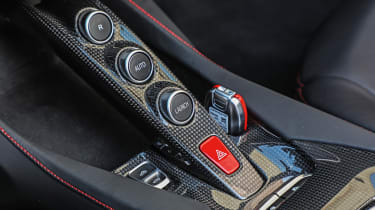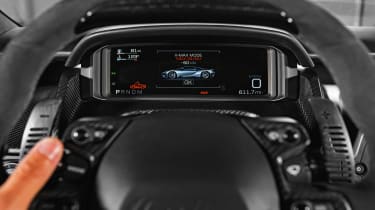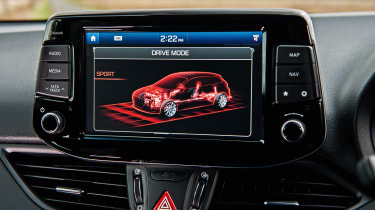Driver modes - do they offer genuine benefits?
More and more cars now come with driver modes. But do they offer genuine benefits, or is it all just marketing hype?
The fashion for driver modes has taken hold in the last few years, with the majority of new performance cars equipped with a button or switch labelled Sport, Dynamic, DNA, Corsa or similar. On the face of it, driver modes look like added value, promising a bit of extra tuning, an increase in performance, for seemingly no cost, but increasingly we here at evo are finding such systems frustrating rather than fulfilling.
There are several reasons for this. Some don’t provide enough tailoring of the systems – throttle, engine mapping, gearshift speeds, damper control – so you can’t select the combination you want. Others require an off-putting trawl through menus and subsequent submenus to make your choices. And sometimes whatever the permutation selected, the end result is still unsatisfactory or offers little improvement over the default state of tune.
> 'Digital driving modes are fine, as long as they add to the thrill of driving'
For instance, in the otherwise excellent Alfa Romeo Giulia Quadrifoglio, to get the loud, growly best from its 503bhp V6, you have to select the sportiest setting (Race mode), which simultaneously disables the traction control – in a twin-turbo, rear-drive saloon equipped with trick Pirelli Corsa tyres. Fine in the dry, less so with a drizzle of precipitation. Meanwhile, on some VW Group performance models almost everything is tuneable – even the air conditioning – so if you can be bothered to trawl through the menus it might take weeks to get the car set up to your taste.
Driver modes have become more commonplace for a number of reasons. The roll-out of electrically assisted power steering (EPAS) makes it simple to offer different levels of steering effort. Similarly, electronic damper control is more affordable than ever and so is more common, and can easily offer ‘comfort’ and ‘sport’ damper forces. Then there is drive-by-wire throttle, which can be given a more responsive setting, and to complement this you can have an uplift in engine sound that increasingly is delivered by piping supplementary ‘engine/exhaust’ sound through the car’s speakers.
It’s simple and cheap to bundle up packages of settings into driver modes, too, which looks great in the showroom, of course; configurations that allow you to have, say, a more comfortable ride and smoother gearchanges for when the family is in the car, then something more dynamic for when you’re on your own. More cynically, perhaps, driver modes offer a way for the salesman to overcome an objection on the test drive: ‘The ride feels too stiff/soft? At the press of a button you can make it softer/firmer…’
When I ran evo’s Fast Fleet SEAT Leon Cupra 300, which offers multiple tuning opportunities – damper stiffness, steering weight, auto gearbox alertness, engine response and more – it took me months to settle on my ideal set-up. I say ideal, but ‘best compromise’ is more accurate, as became clear every time I drove my Golf GTI Mk5 (which has nothing more than a traction control button) and rediscovered what a superb ride and handling balance it has straight out of the box.
It’s obvious: dynamically some cars are better than others – more fun to drive, more engaging, more intuitive. Cars are complicated devices, chock-full of compromises, and some engineers and manufacturers are better at resolving these conflicts than others. Multiple tuning options via controls won’t turn a mediocre car into a great one; if it was possible to make something really good just by light tinkering, surely the car maker would have done so during the car’s development? You can only make it more to your taste.
There will usually be only so much scope to tune on offer – car makers have a duty of care and a dramatic shift in character might catch a customer out. Even the legendary Mitsubishi Evo’s Tarmac, Gravel and Snow settings were not far apart in terms of the changes they brought. For anything greater, such as making the new all-wheel-drive M5 rear-wheel drive, there is an unlocking process, with messages and confirmations along the way.
Then there are cars that are fine in the start-up configuration (a default necessary to meet emissions and noise regulations) but which make it a laborious process to make adjustments. Take our long-term Mercedes-AMG C43. In order to set it to his liking, deputy editor Adam Towler has to go through six button presses: three to select Individual mode, one to put the gearbox in manual, another to select ESP Sport, and one more to turn up the exhaust. How many owners persevere with such processes?
Not that many, by all accounts. Frank van Meel, CEO of BMW M, revealed to evo the truth about those who buy and run M models: ‘Owners of M-cars only experiment with the M modes early on in ownership. Some will settle on a set-up they like – damping and throttle changes, normally – and that will be the one they always drive in. Others will leave the car in the default modes after experimenting, and a tiny percentage will save settings in the M Drive buttons and use them regularly.’ Insiders at other car companies confirm this reality.
Driver modes shouldn’t be ignored, though, because they do work brilliantly on some cars. Take a Porsche 911 on track and you’ll discover that the Sport and Sport Plus modes adjust, among other things, the on-limit balance for less understeer and better turn-in. This is not a simple 10 or 15 per cent uplift in damper firmness but a change to adjust the weight transfer. It’s up to you if you then want to go all the way and turn off the stability control.
Ferrari creates complete dynamic themes for the various drive modes offered by the steering wheel-mounted manettino, aligning handling with ride and throttle and gearbox responses and, in the racier settings, the level of traction and stability control interventions. There’s a definite sense that each of the modes is a balanced, considered, self-contained set-up, not just a variation on the original theme. It’s a set menu rather than à la carte, the only divergence allowed being a ‘Bumpy Road ’damper setting, added at the behest of one of Ferrari’s more influential employees – one M Schumacher.
Interestingly, BMW is offering a different take with its new M850i, which has a very high-tech chassis. For that car, it has restricted the number of chassis options, going as far as to offer only one wheel and tyre size, because it says it knows what the optimum set-up is. It’s hard to argue. Its engineers have driven for many thousands of miles in many scenarios fine-tuning the set-up, going to the very extremes of the abilities of the car and themselves. What they have given you is their best shot at the car they set out to make. So why then does the M850i have driver modes at all? Van Meel again: ‘Some customers may not use them at all but we offer the choice because markets are very different. From what we see and the feedback we have from customers, the US and the UK are the most likely to use the modes.’
That’s probably you, dear reader. But if a car is outstanding in its default mode, spend some time in it before changing it. Every time I drive evo’s Fast Fleet Honda Civic Type R I do so without changing anything because I feel it is just right in its default mode. I only push its buttons when it comes to setting lap times.
So do driver modes add to a performance car’s DNA? If you drive a car and you’re not impressed, walk away. Don’t expect to fix it via a dial or a touchscreen. Sometimes what you’re offered is more a product of the marketing department than chassis engineering.
What we think about driver modes
The Hyundai i30 N does things right. Initially the number of permutations it offers seems ludicrous – three engine modes, four rev-matching options, two for the E-LSD, three exhaust volumes, three damper settings, a trio of steering weights and three levels of ESP intervention. Crucially, though, you can set everything to a custom button to enjoy at leisure. It takes a while to figure out your perfect combination, but it wouldn’t be perfect without all those options to play with. Antony Ingram, Staff Writer
I like how driver modes allow you to alter a car’s personality to suit your mood, the terrain, etc. Also, one needs to appreciate that without esp and very clever TC systems we simply wouldn’t have cars like the GT2 RS and McLaren 720S with around 700bhp, or BMW M5s and AMGs with circa 600bhp. They’d be unmanageable for most punters without safety-net modes, so wouldn’t go on sale. But some systems, have become far too complex – we ain’t all F1 drivers – and done badly they are a pain in the arse. And they are often not needed at all on lower-powered stuff. Plus, they add weight, cost and complication, especially for subsequent owners ten years down the line. Steve Sutcliffe, Contributing Editor
I tend to use the modes to tailor the car’s ride/response/sound to how I’d like it, then stick with that combination. I don’t tend to think, ‘Right, I’m going to drive in a Sport Plus manner now.’ I suppose I try to use the digital tech to find my optimum analogue set-up.
It can feel stupid having umpteen modes on a hot hatch or chunky RS Audi as you never seem to find a sweet spot that you’re prepared to stick with. But it can be great when you’re driving, say, a Ferrari 488. Ferrari does it very well indeed. As much for the way it makes the cars safe and manageable in tricky weather conditions as for the way it enables the car to perform so well on track. Porsche is also very good at it on the regular model 911s. The way each mode focuses or relaxes the car as a whole is very impressive. It never feels contrived.
I’m not sure I’ve driven a car that’s handicapped by its dynamic modes, but it does annoy me when there’s very little perceptible difference between them. Richard Meaden, Contributing Editor
In too many instances driver modes feel more like a case of ‘we’ve done this because we can’ rather than ‘we’ve done this because it improves the car’, the result often an overly complex and baffling array of options that can leave you in no man’s land.
Unsurprisingly, it’s the top-end manufacturers that seem to get it right (Ferrari, Porsche and McLaren, for example), with mid-tier manufacturers (Audi Sport, BMW M, Mercedes-AMG) mistaking an all-you-can-eat buffet of choice as a good thing. Less really is more. I’m unconvinced that hot hatches and superminis offer any meaningful improvement with them.
The biggest frustration is when the bandwidth between two different settings is so narrow you need a laptop to be able to spot the difference. Stuart Gallagher, Editor
As a rule, I’m not a fan, even if from a legislation point of view it isn’t going away. However, Steve makes a great point: without different layers of esp and traction control, there’s no way manufacturers would get away with selling 500-, 600- and 700bhp cars. The hedgerows would be littered with M-cars and AMG metal, let alone the latest crop of supercars. So once you’re offering these different settings, why not add in suspension, steering and engine behaviour?
Nevertheless, I rarely feel modes actually improve a car: all too often it feels like the manufacturer is trying to hoodwink the buyer into thinking they’re getting more ‘car’ for their money. Of course, they’re not, and a car where you’re never quite in the right setting is hugely frustrating. In an ideal world there’d be road and track suspension settings, and that’s about it. Adam Towler, Deputy Editor
The Good
| Alfa Romeo | Ferrari-aping Bumpy Road mode allows a good mix of sharp engine maps with a balanced chassis |
| AMG | Engine and gearshift options work well together |
| Bentley | Offers a ‘Bentley’ mode that the engineers feel is the best fit for the car, but allows further personalisation |
| Ferrari | You can’t separate individual settings but the choices offered are perfectly matched. Bumpy Road mode inspired |
| Hyundai N | At first glance blindingly complex, but the spread of choice allows a perfectly personal set-up |
| Lamborghini | Its individual mode is called ‘Ego’ – what more do you want? |
| McLaren | Simple adjustability of throttle and chassis settings allows maximum flexibility |
| Porsche | Perfect choice for real-world roads (and the Nürburgring) or a billiard table-smooth F1 track |
The Bad
| Alfa Romeo | Can only experience the Giulia Quadrifoglio’s V6 in full-bore mode with ESP turned off |
| AMG | Always tricky to find the damper setting for the situation you find yourself in |
| BMW | Mix ‘n’ match approach to the three core elements (engine, steering, dampers) should work, but rarely does |
| Aston Martin | Not enough differentiation between any of the settings when different modes are selected |
| Audi/Seat/Volkswagen | Plenty of choice but adds little to the mix unless expensive hardware options also selected |



